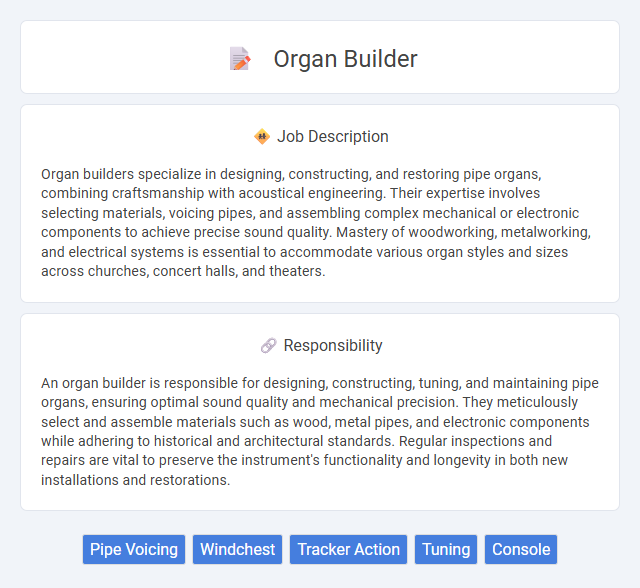
Organ builders specialize in designing, constructing, and restoring pipe organs, combining craftsmanship with acoustical engineering. Their expertise involves selecting materials, voicing pipes, and assembling complex mechanical or electronic components to achieve precise sound quality. Mastery of woodworking, metalworking, and electrical systems is essential to accommodate various organ styles and sizes across churches, concert halls, and theaters.
Individuals with a strong passion for music, exceptional attention to detail, and mechanical aptitude are likely to be well-suited for an organ builder job. Those who enjoy working with intricate components, have patience for precision craftsmanship, and possess problem-solving skills may find the role fulfilling. However, people uncomfortable with manual labor or meticulous tasks might face challenges adapting to this specialized profession.
Qualification
Organ builder jobs require specialized skills in woodworking, metalworking, and acoustics, combined with knowledge of musical instrument mechanics. Candidates typically need a background in mechanical engineering, music technology, or fine arts, along with hands-on apprenticeship experience to master pipe voicing and instrument assembly. Precision, attention to detail, and an understanding of historical organ construction methods are essential qualifications for success in this field.
Responsibility
An organ builder is responsible for designing, constructing, tuning, and maintaining pipe organs, ensuring optimal sound quality and mechanical precision. They meticulously select and assemble materials such as wood, metal pipes, and electronic components while adhering to historical and architectural standards. Regular inspections and repairs are vital to preserve the instrument's functionality and longevity in both new installations and restorations.
Benefit
Organ builders likely experience the benefit of preserving a rich cultural heritage through their craftsmanship, which may provide a strong sense of fulfillment. Working with intricate mechanical and acoustic systems could enhance their technical skills and attention to detail. There is also a probable opportunity for steady demand in churches, concert halls, and restoration projects, contributing to job stability in this specialized field.
Challenge
Organ builder jobs likely involve complex challenges due to the intricate craftsmanship required to design and assemble each pipe organ. The precision needed in tuning and voicing pipes presents a probable need for advanced technical skills and keen attention to detail. Managing delicate materials and historic restoration projects may also pose frequent difficulties in maintaining authenticity and functionality.
Career Advancement
Organ builders develop specialized skills in woodworking, acoustics, and mechanical engineering, enabling progression from apprentice to master craftsman. Career advancement opportunities often include project management roles, custom organ design, and leadership positions within established organ-building firms. Mastery in restoration techniques and innovative digital integration further enhances professional growth and industry recognition.
Key Terms
Pipe Voicing
Pipe voicing is a critical skill for an organ builder, involving the precise adjustment of pipe speech to achieve optimal tonal quality and volume. This process requires expert manipulation of the pipe's mouth, languid, and toe to balance airflow and resonance, ensuring clarity and musical expressiveness. Mastery in pipe voicing directly influences the organ's overall sound character, contributing to its unique acoustic presence in various architectural settings.
Windchest
Organ builders specialize in constructing and maintaining pipe organs, with the windchest serving as a critical component that distributes air to the pipes. The windchest controls which pipes sound by directing pressurized air through valves corresponding to keys pressed on the console. Precise craftsmanship in windchest design ensures optimal airflow, tuning stability, and responsiveness essential for the organ's tonal quality and performance.
Tracker Action
Organ builders meticulously craft intricate pipe organs, utilizing tracker action systems to provide precise mechanical control between keyboards and pipes. Tracker action allows organists to directly manipulate valves, ensuring responsive touch and nuanced sound production essential for classical and historic organs. Expertise in woodwork, metalwork, and acoustic engineering is crucial to maintain the integrity and performance of tracker action organs.
Tuning
Organ builders specialize in the precise tuning of pipe organs, ensuring each pipe produces the correct pitch and harmonics for optimal sound quality. The tuning process involves meticulous adjustment of pipe lengths and voicing to achieve balanced tonal clarity across the instrument's vast range. Expertise in acoustics, woodworking, and metalworking is essential for maintaining the organ's historical authenticity and sonic integrity.
Console
Organ builders specializing in console design engineer and craft custom organ consoles that integrate advanced mechanical actions and digital interfaces for precise control. These consoles serve as the brain of the pipe organ, housing stop controls, keyboards, and pedalboards configured to optimize performer interaction and tonal versatility. Expertise in CAD software and an understanding of acoustics are essential for creating ergonomic, durable consoles tailored to specific architectural and musical requirements.
 kuljobs.com
kuljobs.com